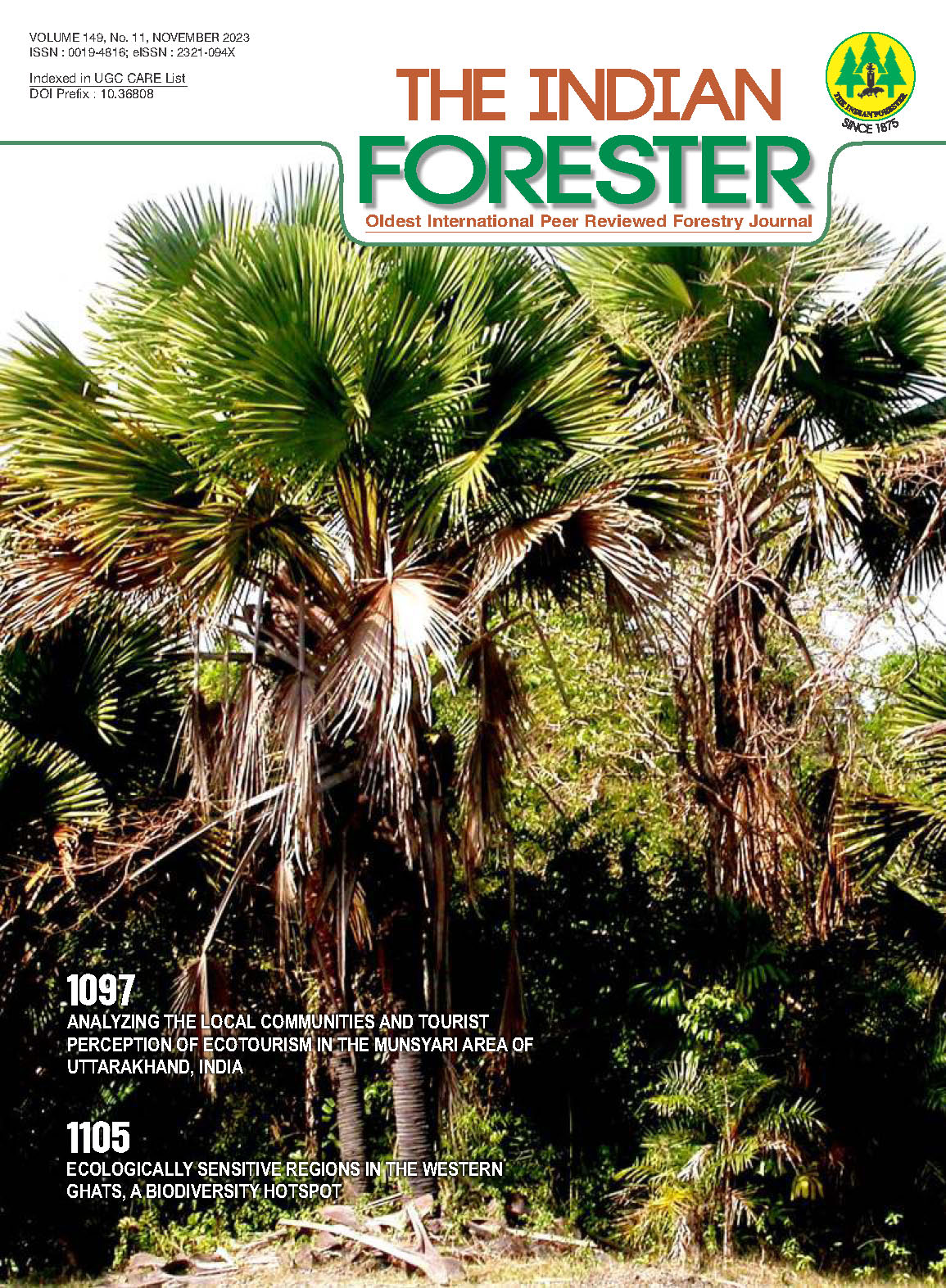Structural Diversity of Trichomes and its Taxonomic Implications in Tribe Cercideae Bronn of Family Fabaceae
DOI:
https://doi.org/10.36808/if/2023/v149i11/169550Keywords:
Bauhinia, Phanera, Glandular, Non-Glandular, Trichomes, Vestiture.Abstract
Vestiture and trichomes are easily observable micro-morphological features present in flowering plants. Vestiture types and trichome micro-morphology of six species belonging to genus Bauhinia L. (s.s.) and Phenera Lour. of tribe Cercideae Bronn was studied using light microscope. The purpose of this study is to examine vestiture type and trichome morphology of these taxa and use of this information in taxonomy. A total of 128 surfaces of vegetative and reproductive parts of these species were observed out of which 80 (68.75%) bear trichomes and 40 (31.25%) were glabrous. Eleven different vestiture types on different plant surfaces (vegetative as well as reproductive parts) were recorded. Key developed here based on vestiture types on vegetative plant parts is useful in differentiating species. Structural diversity of trichome in these species is high with 22 different types of trichomes recorded. Bauhinia displays higher diversity of trichomes with 19 types (4 glandular, 15 non-glandular) while Phanera bear 4 types (2 glandular, 2 non-glandular) only. Key developed using characters of trichomes present on vegetative surfaces can be used in differentiating all studied species. A comparison of vestiture and trichome characters between Bauhinia and Phanera agree with the current separation of these two genera.References
Albert S. and Sharma B. (2013). Comparative foliar micromorphological studies of some Bauhinia (Leguminosae) species, Turk J Bot., 37: 276-281.
Bandyopadhyay S. (2014). Tribe Cercideae (Fabaceae: Caesalpinioideae). In: Fascicles of Flora of India 26 (Singh P. & Bandyopadhyay, S. Eds.) Kolkata, Botanical Survey of India pp 1-72.
Beentje H. (2010). The Kew Plant Glossary (2nd Edn.). Royal Botanic Gardens, Kew 184 pp.
Carlquist S. (1961). Comparative Plant Anatomy, Holt, Rin~hcrt and Winston, New York. pp 29-32.
Duarte-Almeida J.M., Clemente M.S., Arruda R.V.A. and Salatino A. (2015). Glands on the foliar surfaces of tribe Cercideae (Caesapiniodeae, Leguminosae): distribution and taxonomic significance, An. Acad. Bras. Cienc., 87(2): 787-796.
Duthie J.F. (1903). Flora of the Upper Gangetic Plain and of the adjacent Siwalik and Sub- Himalayan Tracts, Volume 1(I) Suprintendent of Government Printing, Calcutta.pp 180-297.
Elbanna A.H., Mahrous E.A., Khaleel A.E. and El-alfy T.S. (2016). Morphological and anatomical features of Bauhinia vahlii Wright & Arnoot. Grown in Egypt, J. Appl. Pharm Sci., 6 (12): 84-93.
Gaur R.D. (1999). Flora of District Garhwal, North West Himalaya: with Ethnobotanical Notes, Trans Media, Srinagar (Garhwal), India. pp 811.
Jain S.K. and Rao R.R.(1976). A Hand book of Field and Herbarium Method, Today and Tomorrow Publisher, New Delhi. pp 157.
Kotresha K. and Seetharam Y.N. (1995). Epidermal studies in some species of Bauhinia L.(Caesalpinioideae), Phytomorphology: Int. J. Plant Morphol., 45(1&2): 127-37.
Leelavathi P. and Rammayya N. (1983). Structure, distribution and classification of plant trichomes in relation to taxonomy. II Caesalpinioideae, Indian J. Forest., 6: 43-56.
Legume Data Portal (2022). Website link: Legume Data Portal (https://www.legumedata.org/).
Lewis G.P. and Forest F. (2005). Tribe Cercideae. In: Legumes of the world (Lewis, G., Schrire, B., Mackinder, B. and Lock, M. Eds.) Kew, Royal Botanical Gardens, pp 57-67.
Mabberley D.J. (2017). Mabberley's plant Book- A portable dictionary of plants, their classification and uses (4th Edn). University Press Cambridge, UK. 1102 pp.
Marinho C.R., Oliveira R.B. and Teixeira S.P. (2016). The uncommon cavitated secretory trichomes in Bauhinia ss (Fabaceae): the same roles in different organs, Bot. J. Linn. Soc., 180: 104-22.
Payne W.W. (1978). Glossary of plant hair terminology, Brittonia, 30(2): 239-255.
Prabhakar M. and Leelavathi P. (1989). Structure, delimitation, nomenclature and classification of plant trichomes, Asian Jour. Pl.Sci., 1: 49-66.
Shukla B.K. and Singh A.N. (2016) Fabaceae. In: Flora of Uttarpradesh (Ranunculaceae-Apiaceae) (Singh, K.P., Khanna, K.K. & Sinha, G.P., Eds.) New Delhi, Botanical Survey of India, pp 364-533.
Simpson M.G. (2019). Plant Systematics (3rd Edn.) Academic Press, New York. 371 pp.
Tucker S.C., Rugenstein S.R. and Derstine K. (1984). Inflated trichomes in flowers of Bauhinia (Leguminosae: Caesalpinioideae), Bot. J. Linn. Soc., 4: 291-301.
Vaidya M.S. and Dalvi K. (2020). Anatomical studies of the medicinally important plant Bauhinia purpurea Linn, JPP., 9: 2103-2106.
Wunderlin R.P. (2010). New combination in Phanera (Fabaceae), Phytoneuron, 19: 1-2.
Downloads
Downloads
Additional Files
Published
How to Cite
Issue
Section
License
Unless otherwise stated, copyright or similar rights in all materials presented on the site, including graphical images, are owned by Indian Forester.





